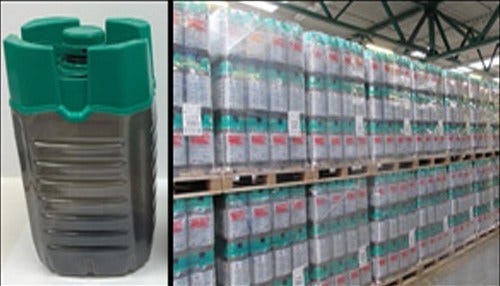LEGO Meets Logistics: Dow Agro Shipping Stackable Bottles
 Dow says eliminating shipping boxes has saved 45
Dow says eliminating shipping boxes has saved 45
Subscriber Benefit
As a subscriber you can listen to articles at work, in the car, or while you work out. Subscribe NowIndianapolis-based Dow AgroSciences moves a mind-boggling amount of product around the globe, and the company just captured an award for changing one of its common containers. The company says, in just nine months, the adjustment prevented nearly 80,000 pounds of CO2 from being released into the atmosphere, saved 45,000 pounds of cardboard box material and eliminated 40 metric tons of packaging paper. The manufacturer says the sweeping change is a relatively simple concept: build a better bottle for farmers, and make it stackable—like LEGO bricks—for shippers.
Dow AgroSciences recently won an Indiana Innovation Award for the new Auto-Stackable 15 liter PET Bottle. The company says the project began in response to farmers and growers wanting a lighter-weight, more manageable container than the standard 20-liter plastic cans.
“The package is the first thing the grower touches, so we want to make sure we’re addressing the convenience and other needs of the grower,” says Dow Formulation & Packaging Global Improvement Leader Ashish Batra. “You can have a fantastic product, but if you supply it in a package that’s very hard for the user to use, that’s diluting the value proposition of your product.”
Dow replaced the original bottle’s side pouring spout with a wide, center neck to prevent glugging and splashing and reduced the bottle’s volume from 20 to 15 liters.
“Rather than use the same material and just make a smaller size—we asked, ‘How do you truly, on a per-liter, per-unit basis, come up with something lighter that still has the strength to be used in all sorts of conditions?’” says Batra. “Or if the farmer were to drop the bottle, it would sustain the impact, for example.”
To meet these demands and further lighten farmers’ loads, Dow switched from using HDPE, a high-density plastic, to PET, a lighter weight plastic that delivers the same strength with less material; the total weight was reduced 30 percent. But farmers were also fed up with the giant cardboard box and packaging paper leftover after receiving a case of product.
“So we thought, ‘How about we design something that could be shipped reliably and consistently without having to use a cardboard box?’” says Batra. “That sparked the idea of this auto-stackability—bottles that can be stacked on each other and palletized with just shrink wrap. You don’t even need to use cardboard boxes.”
While the improvements originated in an effort to help growers, Batra says Dow carefully worked its way backwards along the value chain to create a final bottle design that met each stakeholder’s needs.
“From a manufacturing perspective, we want to make sure these bottles can be filled as fast as possible, and reliably and consistently,” says Batra. “Our logistics partners want to be able to save on logistics costs. They want to make sure they have the best pallet packed and are able to ship the same amount of product in fewer truck loads, for example.”
Dow says it has transitioned five herbicide and insecticide products to the new bottles, but cautions PET isn’t always the answer; scientists must perform sophisticated testing to ensure the product going inside the bottle is compatible with PET; Batra says most of that testing was performed and is still being conducted in Indianapolis.
Dow launched the bottles in Europe about nine months ago, and the company is continuing to test other products the bottles could hold and the geographic markets where they will be most beneficial.
“We’re taking what has been a really nice innovative offering, and starting to proliferate it in as many geographies as we can where it makes sense,” says Batra.
Dow is now creating a family of bottles using a similar design; a 10-liter version will launch next—proof that packaging can be as equally high-tech as the product it contains.
Batra says using less material to make the bottles means a reduction in what needs to be disposed.
Batra says the recyclability of the PET bottles is dependent on each country’s specific regulations.
